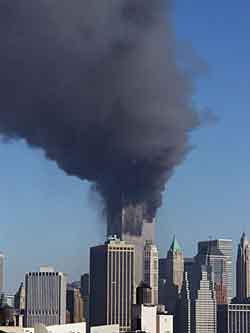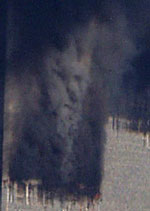|
In 1917, when Marcel Duchamp presented a urinal—which he had christened Fountain—as a signed piece of art, he was reacting to the horror of the First World War and the utter collapse of the gentlemanly notions of progress, beauty and aesthetics that accompanied the slaughter of the generation. Fountain was notorious, and the art world was aghast. Interpretations of Duchamp’s work, and the whole concept of found art, were flowing as freely as an overflowing toilet. But when is a urinal not a urinal? And if it isn’t a urinal, what the hell is it? Fountain was a symbol of ambiguity in very ambiguous times; it is whatever the viewer’s reaction makes it. That is the nature of found art.
Eighty-four years later, the terrorist attacks against New York’s World Trade Center and the Pentagon again threw the world into chaos. The cultural complacency of the United States was forever shattered, and a war possibly as bloody and confusing as World War I—the so-called War Against Terrorism—waits in the wings.
Out of this chaos, another piece of found art has emerged. As the Twin Towers burned, Brooklyn photojournalist Mark D. Phillips was snapping pictures with an Olympus E10 digital camera from a nearby rooftop. One of his pictures shows what appears to be the face of Satan amidst the smoke. Like Duchamp nearly a century before, Phillips’ photo is a piece of found art, and the interpretations of it are coming fast and furious as America tries to find a place for the World Trade Center disaster in its moral and cultural framework.
 Phillips himself didn’t even see the devil in the smoke. "My photo agent was the first to point it out to me. I was surprised," he said in an e-mail interview. On September 11th, Phillips’ response to the attacks was no less visceral than that of the rest of the world. "During something like this instincts take over…I cried while I shot." By mid-afternoon, the photo was already all over the Internet as the world looked into the darkness and flames and tried to make sense of it all. Phillips himself didn’t even see the devil in the smoke. "My photo agent was the first to point it out to me. I was surprised," he said in an e-mail interview. On September 11th, Phillips’ response to the attacks was no less visceral than that of the rest of the world. "During something like this instincts take over…I cried while I shot." By mid-afternoon, the photo was already all over the Internet as the world looked into the darkness and flames and tried to make sense of it all.
The New York Times and Time, the self-appointed arbiters of truth and falsehood for the modern age, grouped Phillips’ photo in with the rash of hoaxes and urban legends that were spread through e-mail and word-of-mouth in the wake of the attacks. But Phillips’ photo isn’t a fake, and the papers of record didn’t bother to examine the evidence: Olympus digital photo files have hidden headers that record any manipulation of the image by computer programs, and the devil pic shows up clean. The arch rationalists of the news media cannot conceive of aesthetic ambiguity, and, of course, in their minds Satan does not exist so they simply declared the photo a hoax, facts be damned. But the image is "really" there, as real as the horses seen in clouds and the fanged vaginas that emerge when staring at inkblots.
Luckily for Marcel Duchamp, not many people had e-mail when he declared Fountain a work of art so he was protected from the opinions of the masses, to a certain extent. Phillips has no such luck. E-mails have poured in, with dozens of different interpretations of the devil photo. One correspondent enthused, "I am glad God used you to take this picture of the enemy, so that the world can see that Satan is real and is at work every day to destroy the lives of God's people." Another of God’s people chimed in with this suggestion: "Has anyone suggested that this could also be an image of a loving God who is so badly HURTING due to the choice of EVIL that has been performed by the terrorists?" The polar opposite of the rationalists, these folks saw proof of their own pre-Enlightenment worldview in a digital image of advanced aircraft destroying modern architecture. The heady philosophical questions of the existence of God in a world where thousands of lives can be arbitrarily snuffed out are neatly truncated and placed into a pre-existing narrative of good versus evil.
 |
| Go ahead, click the picture...we dare you. |
Not everyone has taken so kindly to the photo. A number of folks have castigated Phillips for what they consider a message of hate: how dare he defame a billion Arabs by comparing the actions of a few terrorists to Satan? Of course, this textual interpretation of the image exists only in the fevered minds of the viewer—the connections between the Arab world and Satan are their own. Phillips simply found the art in the smoke; he didn’t conceive it.
Phillips has been personally attacked as well for selling prints of the infamous image. Though he does so at cost and donates proceeds to the post-attack relief efforts, he has been attacked for profiting off the misery of others. One wag got so worked up into a socio-aesthetic interpretive lather that any attempt at developing an analysis of the photo or its artist broke down. Instead, the would-be critic just typed: "THE DEVIL!!!! SATIN!!!" (sic). That’s right kids: silk good, satin evil.
The sons and daughters of dada are also making their voices heard in regard to the photo. The end of the age of irony was declared too soon. There was humor in the gallows, poetry after Auschwitz, and now, wisecracks after the destruction of the World Trade Center and the end of "the end of history." "Look at the nose," one e-mailer said, "it’s either Bob Hope or Richard Nixon." Lori Reaser, a high school English teacher from Charlottesville, Virginia, looked at the photo and decided, after a moment, that it was "Harvey Keitel."
One of the traditional defenses of found art, as art, was simply that an artist found the art and declared it as such. That would be sufficient to let Fountain into the canon; after all, Duchamp could paint and sculpt. And Mark D. Phillips can and does take excellent photographs. But the more powerful proof of the World Trade Center devil photo as art is this—the Internet allows us all to be artists, designers, writers and critics. For the first time in history, the tools of the artist and the mass media’s audience are potentially available to all. Everyone is an artist, and everyone is a critic. The devil photo is art because people react to it as though it is art; it is interpreted, discussed, explored, denounced, celebrated and adopted as our own. Satan laughing while the Twin Towers burn is a symbol of ambiguity in very ambiguous times; it is whatever the viewer’s reaction makes it. That is the nature of found art.
|